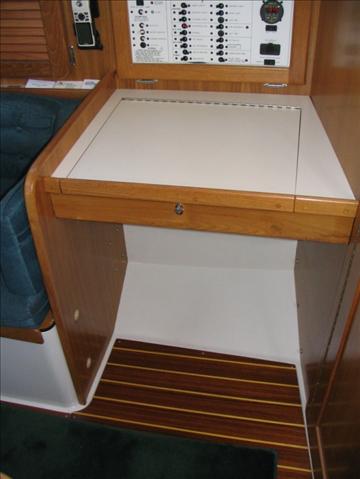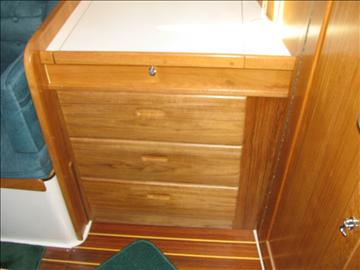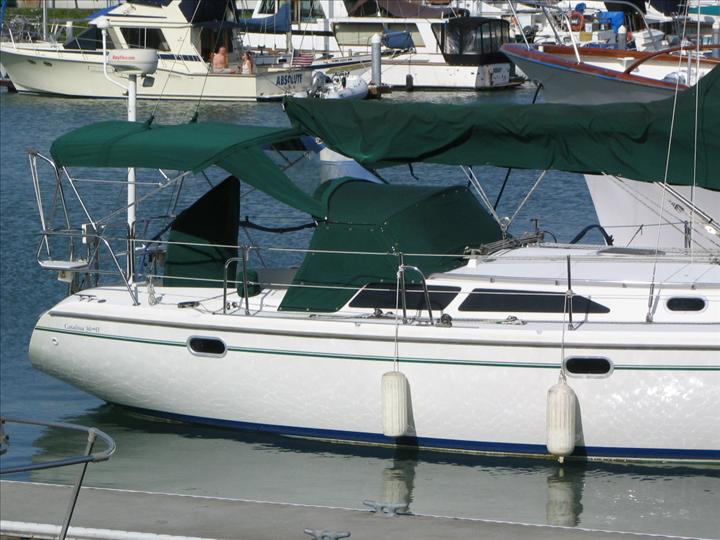Tourmaline appeared to be in pristine condition when purchased in March 2003.
The surveyor seemed to agree that it was in good shape, except for the 4D battery that had been retrofitted. It was dry at the time of survey and someone put water in it before the Trip from Hell, when we took delivery. There were no blisters in the fiberglass. Bottom needed cleaning and painting, which was done immediately.
The first order of business was to replace that battery that nearly exploded on our delivery trip. The 4D batteries were so heavy and so difficult to get out of their tight location, that I hired John Hagan, a marine electronics expert, to replace all three 4Ds with six Trojan wet cell batteries, connecting them into two banks a two battery bank 1 and four battery bank 2. In this process the rats nest of wiring that was found in the battery hatch was connected to a bus with each of the wires identified with a tag for future reference. A new 40 amp Xanex charger was also installed to replace the smaller factory installed charger.
Next on the agenda was to replace the factory installed fixed blade prop with a Maxi Prop, which had proven on my prior boat to provide better thrust in reverse, and slightly better speed overall, with less drag under sail. This prop greatly reduces prop walk in reverse. That alone is a big advantage.
In the process of removing the 4D batteries, the swing out seat under the “navigation” table had to be removed. I put the seat in my attic since it was a very impractical location blocking the main cabin access when in use. A short while later I installed custom teak faced drawers to increase storage space in the boat.
 |
 |
| Before View |
After View |
These drawers were built by a cabinet maker, with drawer faces of solid teak with built in drawer pulls matching others in the boat. The bottom drawer was built with a multi pitch bottom in back to follow the contour of the hull and maximize utility space. The drawers are held shut with a 5 pound magnetic pull, which could easily be replaced with a 10 pound pull if necessary. In significant heeling conditions, the drawers can be held shut by latching the aft cabin door at right to a hook at the counter level.
The drawer project was first seen on another CATSS boat which had five drawers, each shallower than mine. In considering this project it is important to know what the intended contents of the drawers will be. In the case of the five drawer layout I saw, the owner used the drawers to contain tools, laid out on a foam pad, convenient for use in working on the engine. My drawers were designed to fit CDs and DVDs, which fill the center drawer. The bottom drawer contains spare filters, impeller, belt, sail tape, zinks, and a few tools needed for the replacement of these items. The top drawer contains miscellaneous other equipment – hand held GPS, spare batteries, binoculars, etc.
Here is what the area looks like with the drawers removed.

In 2008 it was time to forget the aesthetics of my open cockpit and install a bimini cover with a large good quality windshield to keep the perpetual drizzle out of my face when sailing in the Pacific Northwest climate. The deteriorated windows in the dodger were replaced and the canvas installer thought the Sunbrella material had a good five years life left in it, so it was simply cleaned and re-stitched. Matching Sunbrella material was used for the bimini top.

This bimini top was added for protection from the rain, but it stays up most of the time because it shields the cold air and adds great comfort to cruising on colder days. It also shields radiation from the hot sun every July 15th when that occurs.
In 2009 I replaced the original Raytheon black and white GPS over the main companion way with a Ray Marine E120 and added a Ray Marine E80 to the wheel stanchion. At the same time a smart auto pilot Ray Marine ST6002 replaced the original Raymarine auto pilot that was not working reliably, and replaced the old shades of grey radar with the new black background and bright yellow images. The AIS package was included in this installation and I am very pleased with the entire setup.
I can watch the GPS under my nose at the helm and still see the radar clearly in the companion way. Of course a variety of screen combinations can show either or both of these at either station and the radar can be overlaid on the GPS chart. The GPS does a great job tracking to any preset point. Just make sure you don’t set the point with some shallow water or an obstruction between the point and where you are! The skipper still has to maintain vigilance because the auto pilot doesn’t have eyes.